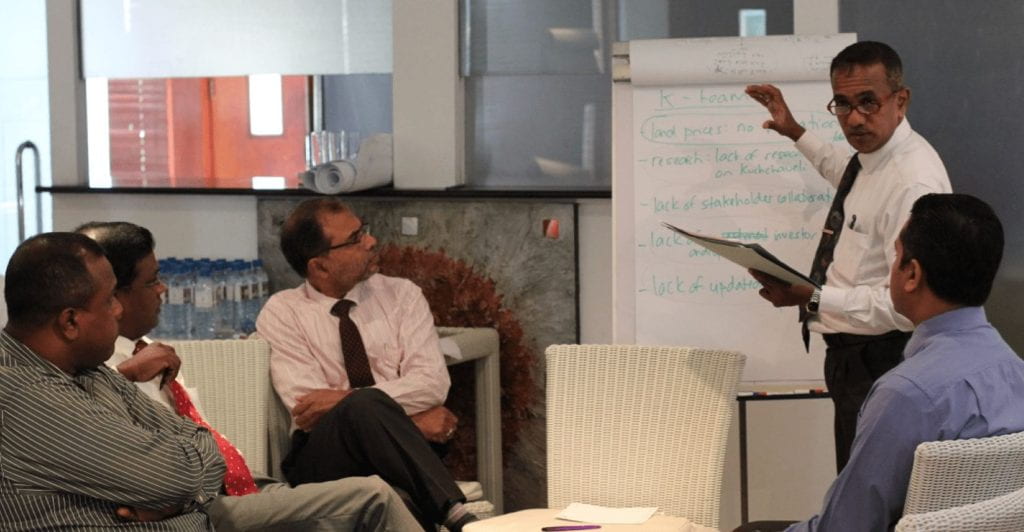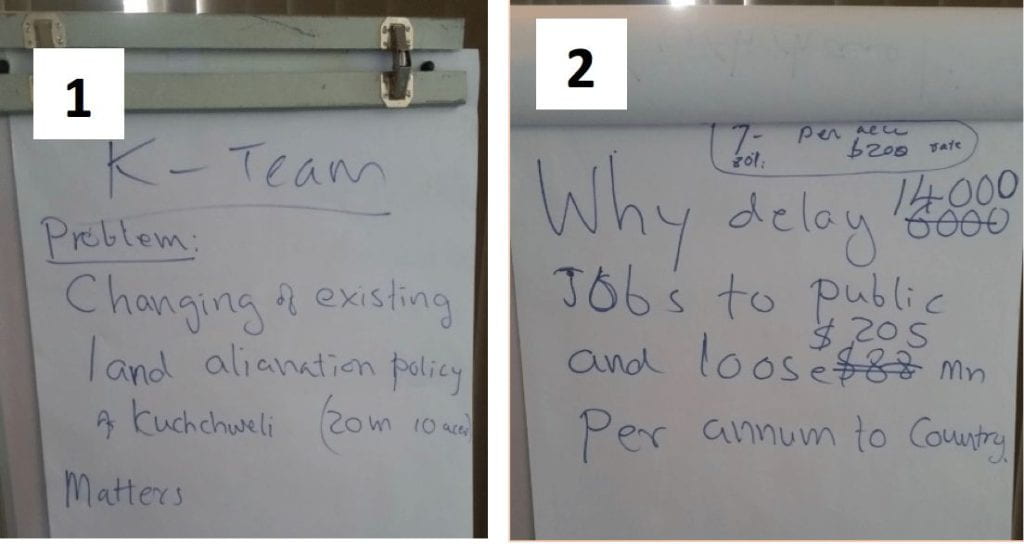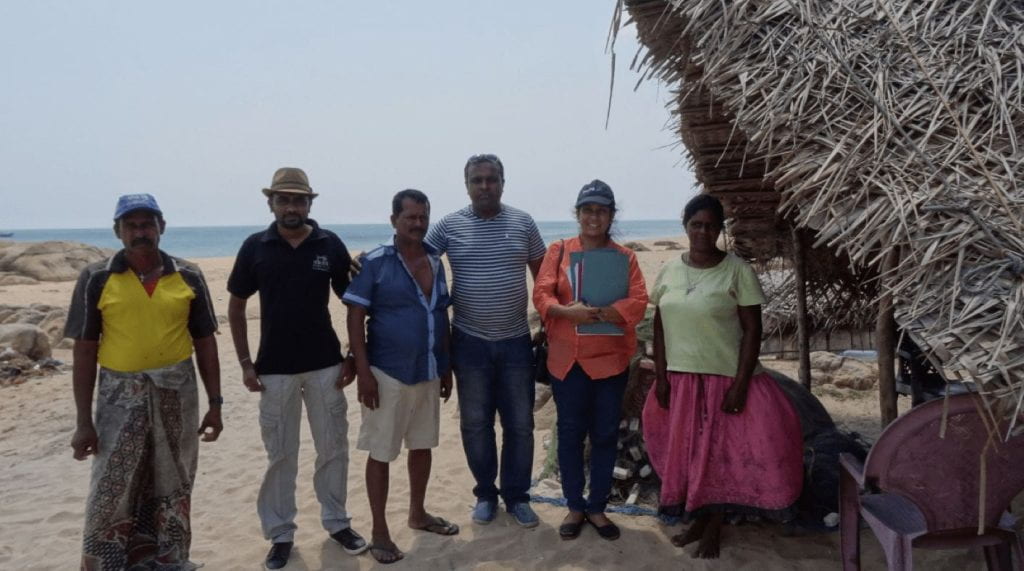Written by Tim McNaught and Anisha Poobalan

Tourism is a strong contributor to Sri Lankan economic growth. The bulk of development in this sector has been in the south and west of the island. The northern and eastern regions, the areas most affected by the civil war and most in need of an economic boost, have experienced slower development. In an effort to promote tourism in the east, the Sri Lanka Tourism Development Authority (SLTDA) put together a team to work on the Kuchchaveli project. The K-team was part of the Sri Lanka PDIA project from September 2016 – September 2017.
The team was initially challenged with constructing the problem, which included identifying what the problem was and why it mattered. The team’s first problem statement, “Changing of existing land alienation policy” (Figure 1), was an accurate assessment of the situation but failed to promote immediate and urgent action. The team reflected further and a few quick calculations on the opportunity cost of inaction led the team to ask “Why delay 14,000 jobs to [the] public and [lose] $205 mn per annum to country?” (Figure 2). Now this was a problem that could be rallied around. Instead of being framed simply from the perspective of potential investors, it clearly quantifies how solving this problem could boost the economic well-being of an entire community. This sense of urgency is essential to building momentum towards action.

The team deconstructed their problem statement to its root causes by listing several contributing factors, including: high land price, lack of stakeholder collaboration, and a lack of infrastructure facilities (see Figure 3). The team organized many of these underlying causes in an Ishikawa (or Fishbone) diagram.

Team members were asked to identify the criticality and accessibility of each strand. ‘Criticality’ focused on the importance of the cause to the problem and ‘Accessibility’ focused on whether the team felt they could do something to address the problem in the short run. This analysis led the team to identify five areas where they should and could start acting: 1. No proper valuation of land; 2. Lack of research/information on Kuchchaveli; 3. Lack of stakeholder collaboration); 4. Lack of investor analysis; and 5. Lack of an updated/strategic plan.
The K-team outlined an action plan and got to work. The team worked in tight two-week iterations, during which they pushed themselves and others towards action. At the end of each iteration, a PDIA team member would check in with the team asking four key questions: What did you do? What did you learn? What is next? What are your concerns? This combination of learning while producing results is key to building new capability within teams and ultimately within whole organizations. Every month, the CID facilitators conducted a workshop for all the PDIA teams to meet, present their progress, share the challenges they faced and learn from each other. At the first workshop, the K-team shared some concerns with time allocation and team commitment. The team seemed to have lost focus, lacked motivation and needed help creating a clear goal for the coming months. The CID facilitators worked with the K-team to come up with a more specific end-goal: “By March 2017, we will reconstruct and resurrect the Kuchchaveli project so that it is ready for investment and to be a place where community jobs are created and the community is deeply connected to tourism. In particular, we aim to be discussing investment opportunities with at least 5 new investors about at least 75 acres.”
The K-team responded positively to this structured support and the team soon settled into the new work flow, making progress with a revived energy. “So many people come to collect information, then they put down their ideas in a document and give it to us to act on. This just ends up on a shelf. It’s better not to talk, but to do something – so we are happy! Especially the support from the higher-level authorizers has given us confidence to keep working.” Their immediate authorizer adopted a more hands-on approach, attending team meetings and checking in with their team leader regularly. This gave their work increased legitimacy, a crucial factor in the PDIA process. The K-team became much more proactive. When a challenge came up they immediately discussed how they could solve it and set deadlines for themselves. The team allocated time for weekly meetings and this soon became routine. An agenda was circulated every week which gave structure and purpose to each meeting. Those who were not able to maintain their commitment were replaced by those who could, and they continued the good work.
Eventually, the team realized that to envision the tourism project they were working towards, they would need to go on a site visit to better understand the Kuchchaveli area and to engage with key stakeholders. As the team leader pointed out: “Since this is new for us we have to break our own path (cut through the jungle) but even so we need to know what our destination looks like. We have to visualize – how will our visitors get there and what new capacities do we need.” They developed a list of prioritized stakeholders and set up meetings for a full day of engagement. In their third month of work on the Kuchchaveli project, the team conducted a site visit. There they met with the manager of a hotel in the area, investors awaiting the land revaluation and local government officials and the community. At their next meeting, the team discussed how efficient and productive the site visit had been. They were pleased with their progress. They presented to more authorizers within the government and expanded their support. The team was able to respond to questions from their superiors, indicating their hard work and in-depth understanding of the project. The K-team shared how these meetings increased their confidence, especially knowing they were backed by higher-level authorisers. Acting on feedback from these meetings, the team began to work on a vision for the types of development they wanted: nature-oriented, luxury and activity focused tourism. They took steps towards improving the infrastructure in the area, specifically regarding transport, electricity, waste management and water supply. They also started work on a concept paper with their plan to include the community in the development, a description note for investors and began discussing the appointment of an investor selection committee. The team listed out certain reputed investors to target so that they would attract the desired tourists to the area. With structured, short bursts of work and reflection, the team was emerging with innovative strategies and learned capabilities to develop a sustainable tourism project.

The K-team was learning to profile a tourism project. This learned capability was recognized by their PDIA peers and the other government teams requested meetings to learn from the K-team. This capability could be used across the board, with any tourism project these officials came across. They now had the expertise to know where to start, what was important and whom to engage with. The team’s capability had grown immensely over the past few months, but they needed the land revaluation policy to be passed. Until this was complete, they could not give investors the green light. The team soon found that they had done all the ground work possible and still the policy was at a standstill. They pushed hard but to no avail. They were discouraged and began to lose their motivation and momentum. They decided to compile a document with the Kuchchaveli project plan and then move on to another area while they waited. Since they now had the capabilities to profile a sustainable tourism project, this was a smooth transition and the team was able to employ a similar approach in a much more efficient manner. They functioned like a well-oiled machine and this ability to transfer their learned capabilities to any tourism project that came their way, was the true success of the Kuchchaveli Team! As one team member says in the K-team video: “We are happy that we now have a complete model done which can be applied to any part of the country as a model integrated tourism resort project!”
Meet the K-team and listen to what they have to say in the video below!
